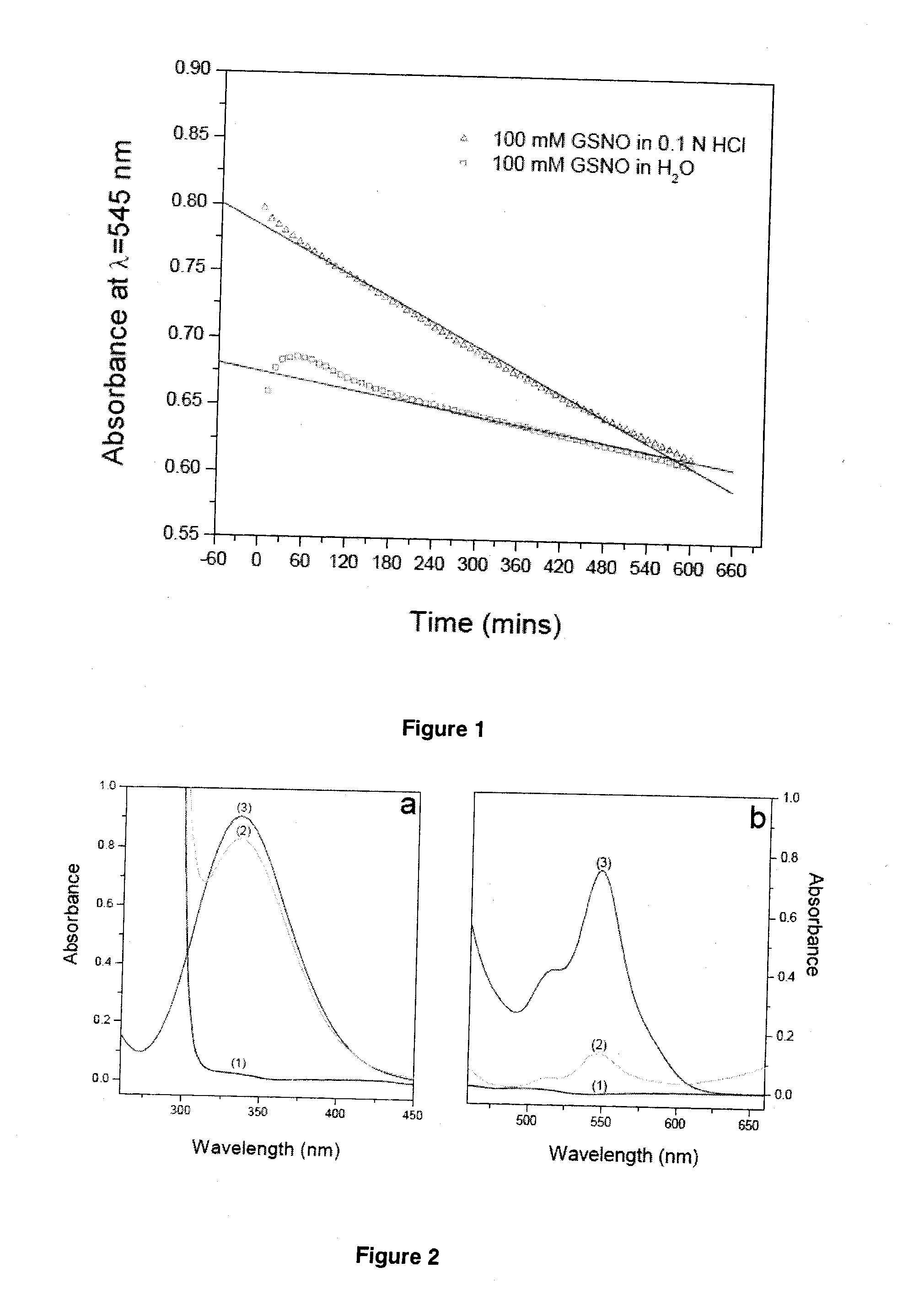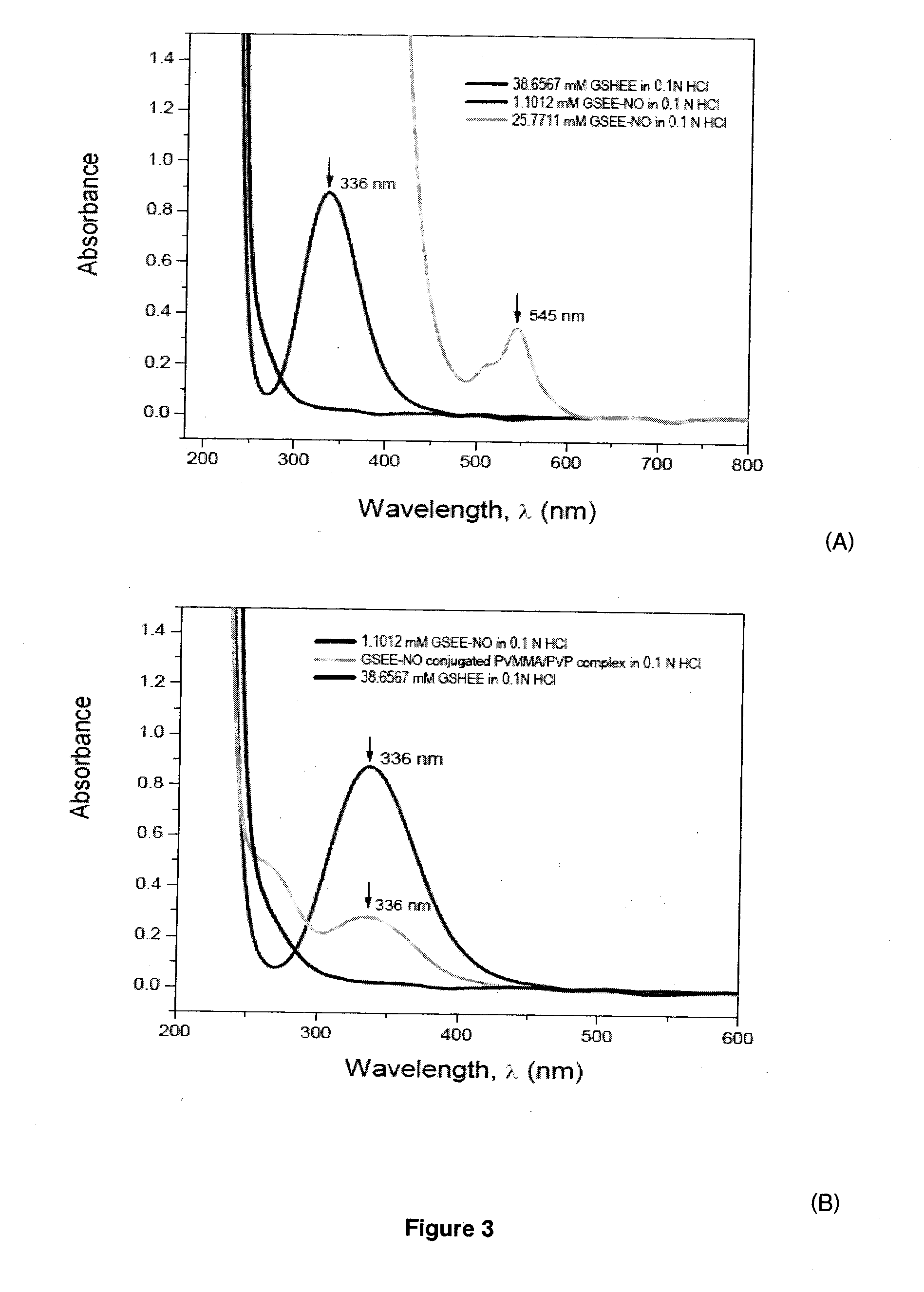Supramacromolecular polymer complexes providing controlled nitric oxide release for healing wounds
- Summary
- Abstract
- Description
- Claims
- Application Information
AI Technical Summary
Benefits of technology
Problems solved by technology
Method used
Image
Examples
example 1
Synthesis of RSNOs
[0124]Synthesis of RSNOs is accomplished via nitrosation of thiols according to the following reaction equation,
RSH+(HNO)2→H3O+RSNO+H2OEquation(1)
[0125]The reaction is very rapid, effective, and quantitative at least from the synthetic viewpoint. However, this reaction often generates unstable product in its pure state. The homolysis of RSNO giving rise to disulfide bridge formation, as described in the reaction equation below, is the main mechanism responsible for its thermal instability.
RSNO+RSNO→metal,heat&lightRS-SR+2NOEquation(2)
Detailed information about this reaction will be described in the following examples.
A. Experimental Procedure for Preparing GSNO
[0126]GSNO was readily prepared by reacting reduced glutathione (GSH) and equimolar nitrites in acidic medium protected from exposure to light.
[0127]Briefly, to a stirred ice-cold solution of glutathione (GSH) (154 mg, 0.5 mmol) in 5 ml of 0.2 N HCl was added a portion of NaNO2 (35 mg, 0.5 mmol). This rea...
example 2
Conjugation of RSNOs to PVMMA
[0133]A notable character of maleic anhydride copolymer is the well-known high reactivity of the anhydride moieties with primary amine groups, and to lower degrees, with alcohols. This reaction can be performed either in the dissolved state of the copolymers or via surface chemistry following interfacial presentation of some bioactive molecules. Such acylation reaction can take place under generally mild conditions, which, in the present case, was accomplished spontaneously at room temperature within 20 min.
[0134]In principle, all RSNOs containing primary amine group are capable of reacting with maleic anhydride copolymers such as PVMMA according to Scheme 5. Such reaction also resulted in the formation of free carboxylic acid group, which are essential in providing protons for the subsequent essential step of forming intermacromolecular complexes with a second polymer. It is very important that RSNO should be prepared first before conjugation with PVMMA...
example 3
Complexation of RSNOs Conjugated PVMMA with PVP
[0142]The complexation of RSNOs-PVMMA and PVP is based on the interpolymeric hydrogen bonding interaction shown in Scheme 6.
A. Preparation of GSNO-PVMMA / PVP Complex
[0143]To prepare the GSNO-PVMMA / PVP complex, a 6.36 wt % PVP solution was first prepared in a mixture of 10:1 (volume ratio) acetone and ethanol. Since PVP can not be dissolved in pure acetone, a certain amount of ethanol has to be added to facilitate the solution preparation in accordance with the composition of the corresponding GSNO-PVMMA solution.
A1 Preparation of GSNO-PVMMA / PVP Complex with 7.52% GSNO Loading Relative to PVMMA
[0144]3 ml ethanol was firstly added to a GSNO-PVMMA solution (10 / 1 acetone / 0.1 N HCl according to Example 2A1) prior to the complex formation. Subsequently, a measured amount of PVP solution was quickly poured into the GSNO-PVMMA solution under vigorous stirring in an ice bath. As the complex formation took place through intermolecular hydrogen bon...
PUM
| Property | Measurement | Unit |
|---|---|---|
| Time | aaaaa | aaaaa |
| Composition | aaaaa | aaaaa |
| Adhesivity | aaaaa | aaaaa |
Abstract
Description
Claims
Application Information
 Login to View More
Login to View More - R&D
- Intellectual Property
- Life Sciences
- Materials
- Tech Scout
- Unparalleled Data Quality
- Higher Quality Content
- 60% Fewer Hallucinations
Browse by: Latest US Patents, China's latest patents, Technical Efficacy Thesaurus, Application Domain, Technology Topic, Popular Technical Reports.
© 2025 PatSnap. All rights reserved.Legal|Privacy policy|Modern Slavery Act Transparency Statement|Sitemap|About US| Contact US: help@patsnap.com



